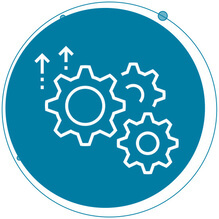 Traditional mass spectrometry ionization methods such as electronic spray ionization (ESI) and matrix-assisted laser desorption ionization (MALDI), are popular methods for detecting the molecular weight of proteins, peptides, and other biologics. The reason being both methods allow for measurement of large molecular weight1 while their sensitivity leads to accurate quantitative and qualitative results.
Traditional mass spectrometry ionization methods such as electronic spray ionization (ESI) and matrix-assisted laser desorption ionization (MALDI), are popular methods for detecting the molecular weight of proteins, peptides, and other biologics. The reason being both methods allow for measurement of large molecular weight1 while their sensitivity leads to accurate quantitative and qualitative results.
Two Principal Disadvantages of These Methods
However, let’s say you are in the lab running thousands of samples. Both ESI and MALDI require advanced sample prep via capillary electrophoresis (CE) or liquid chromatography (LC) analysis. Additionally, the apparatus itself is difficult to clean due to previous contamination from various residues2. These factors are probably two of the prime disadvantages of these methods.
The Solution
What if there was a way you could control the formation of ions only when data collection is required? That is the topic of this tech note, Increasing System Robustness with Ion Formation Control. Researchers in the study significantly extended their system operation before instrument cleaning was required, thus, saving time.
The Key to Scheduled Ionization Success Is in the Software
A version of Analyst® software 1.7 was used for acquisition. This version turns off the ionization voltage when no data collection is required. The ionization voltage is also turned off once data collection is complete and remains off until the LC method is completed, and turned off between samples. This mode of operation, where the ionization voltage is turned on for data collection only, is referred to as Scheduled Ionization. Using this approach, all conventional acquisition workflows (MRM, Scheduled MRM™ algorithm, IDA, SWATH® Acquisition) can be supported with a common user interface.
The Take-Away
Controlling the ion formation can effectively reduce contamination of ion optics under analytical conditions. By scheduling the formation of ions, it is possible to extend the use of the instrument over prolonged duration due to the reduction of contamination of the front end.
Also, these benefits are like using a divert valve, but without the complexity of additional hardware. As MS instruments move into more routine and automated environments, fewer operator interventions are needed.
Download the tech note to learn more about how the Scheduled Ionization feature can offer you at least 2X longer sustained instrument operation before required cleaning.
Ready to improve your lab’s productivity with Analyst Software 1.7? Find out more about how to upgrade >Download Tech Note >
References
1. http://chemistry.emory.edu/msc/tutorial/mass-spectrometry-ionization.html
2. https://chem.libretexts.org/Core/Analytical_Chemistry/Instrumental_Analysis/Mass_Spectrometry/mass_Spectrometers_(Instrumentation)/Electrospray_Ionization_Mass_Spectrometry






 Contact Support
Contact Support
0 Comments